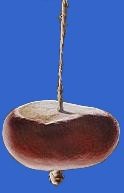 Project Britain
Project Britain
British Life and Culture
by
- Search our Site
- Project Britain
- Calendars
- Facts and figures
- London
- Great Britain
- Union Flag
- A-Z of Britain
- Customs & traditions
- Britain today
- Daily Life
- Money
- Etiquette
- Monarchy
- Government
- Education
- Tourist Information
- Food and drink
- Sports and leisure
- History
- Kings and Queens
- Superstitions
- Glossary
|
Conkers around the world
A Favourite Children’s Game |
|
|
‘I chanced upon your website while surfing and saw your page on the game of conkers. In Puerto Rico we have played a similar game for decades,only we use the seed of the carob tree, which grows in woody pods in a meaty substance which stinks to high heaven, and we call the game "gallitos" which is Spanish for "Little Cocks" or"Little Roosters". I remember fondly spending many hours playing the game, but today it seems to have disappeared, what with youngsters engrossed in electronic pastimes. I am happy to learn that that it is still being played in other lands.’
‘ I have been a fan of the British author, Terry Pratchett for some time. Recently I was reading some annotations on his book, Pyramids, in which the sentence “It’s rather like smashing a sixer in conkers.” was explained. Much to my surprise, I found out that a game I THOUGHT was solely native to us children that grew up in the North West Bronx in New York City was actually a British children’s game also! As a child growing up in The Bronx, NY we would travel up to the “rich” section of The Bronx, Fieldstone, to get our Horse Chestnuts. Most of these were found laying on the ground but the adventurous child(myself included) would climb up the tree and pick off live ones! Once home with the chestnuts the usual ritual would begin. Boring a hole thru the centre of the chestnut, usually with a 10 penny nail and a hammer. Then stringing a shoelace through the chestnut. We would bring in our pride possessions to the school and the battles would begin. Shot for shot until someone’s chestnut shattered and the winner was given a “age”. I had seen some chestnuts win up to ten(10) rounds before succumbing to defeat. To harden the chestnuts we would soak them in vinegar and let them sit for a few days, or even coat them with nail polish (did our mothers EVER get angry!!!) to harden the shells. I am glad to see that this was not just something that was part of my regional upbringing. It is refreshing to know that some things are passed on to others even if they DON’T know where they came from! Thanks for letting me share this with you.’ John McNamara
I enjoyed your Web site! I grew up in Toronto, Ontario and I have fun filled memories of playing at recess during October in the 1960’s. My father also played in the late 1920’s. In the autumn we would go to an area known as Chestnut Hill and gather a basket of chestnuts. We just called the game ‘chestnuts’ and baking or modifying the chestnuts to increase the hardness was not permitted. We would use a lace from an ice hockey skate for the string. The striking pit was usually sand although a cushion or carpet was used at home. I support your hope that ‘conkers’ will continue as a traditional children’s game (along with hide & go seek). I will pass your web site along to help continue the tradition in Canada.
I just read on your website about the chestnut game you call "conkers". We played it in the Buffalo, New York (USA) area back in the 1950s. We had no special name for it – I think we might have called it "Chestnut Wars". I believe it has been in the US for many years, but only in areas where there are chestnut trees. The area around Buffalo has a lot of chestnut trees. I have also seen the game referred to as "knockers", but that is not a good word to use around women.
‘As a child in Toronto in the ’70s, I played conkers every autumn. It was a game exclusive to the school playground – I can’t recall playing the game anywhere else. We played the terrestrial variation, our chestnuts placed for striking in a small hard-packed depression in the ground. We called the game chestnuts. Hard, game-winning conkers were called rockers; soft, unworthy nuts were referred to as butters. Typical Canadians, we used hockey skate or leather laces for the string.’ |
|
 © Copyright – please read © Copyright – please read All the materials on these pages are free for homework and classroom use only. You may not redistribute, sell or place the content of this page on any other website or blog without written permission from the . |
© Copyright 2014
is the creator of the Woodlands Resources section of the Woodlands Junior website.
The two websites projectbritain.com and primaryhomeworkhelp.co.uk are the new homes for the Woodlands Resources.
left Woodlands in 2003 to work in Kent schools as an ICT Consultant.
She now teaches computers at The Granville School and St. John’s Primary School in Sevenoaks Kent.
Woodlands Junior Homework Help new website
